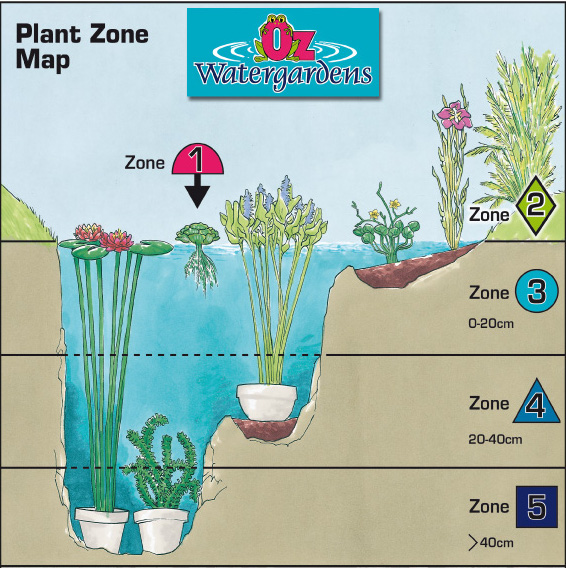Zone Map
Choosing plants for your pond made easy...
Oz Watergardens have developed an easy to use guide for plant selection, by grouping plants according to their optimum water levels (planting zones). Oz Watergardens pond plant zone system™ divides the pond into 5 planting zones, as shown on theOz Watergardens Zone Map. Each plant zone is referenced using a numbered colour symbol. All plants listed on our website, or grown and supplied by Oz Watergardens are labeled with these plant zone symbols. We also provide our retail nurseries and garden centre with a copy of the Zone Map (Pond picture) as an easy to use guide to pond plant selections.
The Plant Zones encompass floating or drifting plants through to fully submerged water plants. The water depth is measured from the crown of the plant (usually at the soil surface of the pot) to the pond surface.


ZONE 2 (GREEN) For pond edges or bog areas. eg. Tassel Rushes, Pennyworts, Sweet Flags, Irises and plants that like wet feet.

ZONE 3 (LIGHT BLUE) 0-20cm plant depth. Suitable for marginal or bog plants like Water Irises, Milfoils and some grasses.

ZONE4 (MID BLUE) 20-40cm plant depth. Ideal for smaller water plants such as Miniature Waterlilies, Water Poppies, Water Fringes and large marginal plants such as Rushes, Reeds and Sedges.

ZONE 5 (DARK BLUE) 40cm or more in depth. Recommended for Waterlilies, Lotuses and underwater plants.
Planting zone.....The key to a healthy pond.....
All well designed water gardens incorporate plants from each of the 5 pond planting zones. By selecting a range of plants from each plant zone, your water gardens can establish a more balanced environment and improved pond health. In essence you create a miniature version of what occurs in nature.
A small natural ecosystem, bringing life into your garden.
We should all take a second look at ponds in gardens, as a way to help bring nature back into our environment. We have all had an impact on the environment through clearing the land and development that we feel improves our quality of life…..but have we really? By introducing ponds into our gardens we are actually giving something back to our already stressed urban environment.
How can one pond be a positive for the environment?
The power of one….(seems like a great title for a book). Building one pond in your backyard may not seem like you are creating a habitat, but imagine if a thousand of your neighbours, also had one. Surely there would be some positive impact on your local ecology.
Your pond is the grassroots level to improving your environment.